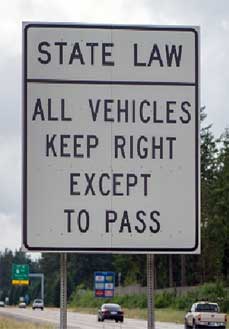
We have all seen all over the news recently about Seattle and Washington State’s crackdown of left lane drivers/campers by Washington State Patrol. The Washington State Patrol will be doing a focused effort June 20-22 to crack down on left lane campers. We all like that police are cracking down on drivers in the left lane driving too slow, but what does the law actually say?
Many news media are reporting that the left lane is only to be driven in when passing someone or for emergency lane use only. Is this right, or is it to only stop people that are driving slow in the left lane and what is slow? Does slow mean driving under the speed limit? Is the left lane only for people driving over the speed limit then? Let’s examine the law to figure out what it actually says and means.
The Washington State Patrol released a statement that has been interpreted by news media far differently but here is what it actually says:
RCW 46.61.100 requires all vehicles to keep right except when passing on multiple lane roadways. Left lane “campers” are drivers who remain in the passing lane (left lane) for long periods of time without passing.
The WSP targets left lane violators to educate them on the consequences of “camping” in the left lane. Left lane camping can lead to road rage, aggressive driving, traffic congestion, and collisions. If you’re caught camping in the left lane it could result in a $136 ticket.
RCW 46.61.100 – Keep Right Except When Passing, etc.
(2) Upon all roadways having two or more lanes for traffic moving in the same direction, all vehicles shall be driven in the right-hand lane then available for traffic, except (a) when overtaking and passing another vehicle proceeding in the same direction, (b) when traveling at a speed greater than the traffic flow, (c) when moving left to allow traffic to merge, or (d) when preparing for a left turn at an intersection, exit, or into a private road or driveway when such left turn is legally permitted. On any such roadway, a vehicle or combination over ten thousand pounds shall be driven only in the right-hand lane except under the conditions enumerated in (a) through (d) of this subsection.
(4) It is a traffic infraction to drive continuously in the left lane of a multilane roadway when it impedes the flow of other traffic.
What does it mean? These are the two relevant passages of the law that figure into when someone can drive in the left hand lane and when they must not drive in the left lane. Basically, the law is saying that you must drive in the right hand lane when it is open. Does this mean the far right lane or does this include the center lane?
If this is taken from the context of what is written it appears to be saying on a three lane road that all traffic is to drive in the far right lane. Then if someone is driving faster than a person in the far lane, they may drive in the center lane. If someone is driving faster than traffic in the center lane, they may drive in the far left lane. However, once each person has overtaken the other driver, they must move to the right lane again unless someone is driving slower than them in this lane.
When do people get in trouble then by the police? RCW 46.61.100(4), however, states that it is only a traffic infraction when someone is driving in the left lane when it impedes traffic behind them. Therefore, you can only get a ticket when you are blocking people behind you, it appears. Therefore, you can drive in the left lane or center lane when you are driving faster than the car on your right but you may get a ticket if there is someone behind you that wants to drive faster than you in the far left lane. You need to move over if someone is driving faster than you no matter if they are going over the speed limit.
Tricky Scenario? Basically the police have a decision to make at this point, do they want to target the speeder who is going over the speed limit in the far left lane or do they want to go after the person driving the speed limit who is technically passing someone in the middle lane who is going slower than them? The speeder could technically be right on the person in the far left lanes butt and then continue to go far over the speed limit but the police officer could pull over the person who is driving the speed limit and passing someone on the right because the law says they are impeding the flow of traffic behind them.
The left lane is the lane that people drive the fastest in and is the lane of traffic in which the most severe car accident happen in. This is because speed is the biggest contributor to determining how severe a car accident will be. However, most car accidents occur in the far right lane but those are less severe and are generally due to merging traffic going on and off the freeway. Seattle personal injury lawyers have seen these car accident scenarios far too often.
If you have been injured in a Seattle or Washington State car accident, please contact me ASAP before you lose your rights or give away your case for far less than you deserve.
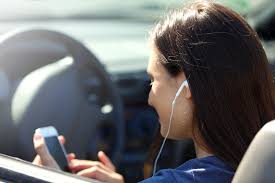 What is somewhat misleading is the fact that you can wear blue tooth enabled headphones and listen to your iphone podcast or music but you cannot wear chorded headphones even though they both function basically the same. I guess the reasoning behind this is that the chord could cause a driving hazard, which could cause a car accident.
What is somewhat misleading is the fact that you can wear blue tooth enabled headphones and listen to your iphone podcast or music but you cannot wear chorded headphones even though they both function basically the same. I guess the reasoning behind this is that the chord could cause a driving hazard, which could cause a car accident.
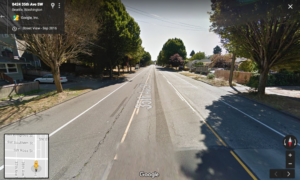 How far can you go in a turn lane to make a turn? If you are planning on taking a left turn into a business in a turn lane, you cannot use this lane unless the business you are turning into is less than 300 feet away or about the length of a football field. This is not very far.
How far can you go in a turn lane to make a turn? If you are planning on taking a left turn into a business in a turn lane, you cannot use this lane unless the business you are turning into is less than 300 feet away or about the length of a football field. This is not very far.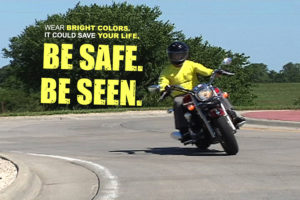 Motorcycles are dangerous because of their vulnerability to crashing and high likelihood of severe injuries suffered by the rider if there is a crash. Motorcyclists are only protected by the protective clothes they wear like leather coats, jackets, vests, and pants – of course the helmet as well. Any time a rider is struck by a car, there is a high likelihood of hitting the pavement and even being run over by other cars.
Motorcycles are dangerous because of their vulnerability to crashing and high likelihood of severe injuries suffered by the rider if there is a crash. Motorcyclists are only protected by the protective clothes they wear like leather coats, jackets, vests, and pants – of course the helmet as well. Any time a rider is struck by a car, there is a high likelihood of hitting the pavement and even being run over by other cars.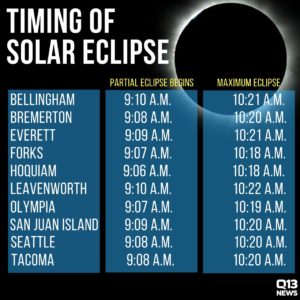 This years solar eclipse will start around 9:08 a.m. and maximize at 10:20 a.m., where 92-93% of the sun will be blocked by the moon in Seattle. The partial solar eclipse will last until about 11:38 a.m. This means that most people will be at work on Monday when the eclipse starts. However, if you are on the road, traffic may be dangerous as people slow to look at the sun.
This years solar eclipse will start around 9:08 a.m. and maximize at 10:20 a.m., where 92-93% of the sun will be blocked by the moon in Seattle. The partial solar eclipse will last until about 11:38 a.m. This means that most people will be at work on Monday when the eclipse starts. However, if you are on the road, traffic may be dangerous as people slow to look at the sun.
